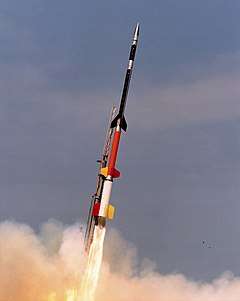Norwegian rocket incident
The Norwegian rocket incident, also known as the Black Brant scare, occurred on January 25, 1995 when a team of Norwegian and US scientists launched a Black Brant XII four-stage sounding rocket from the Andøya Rocket Range off the northwestern coast of Norway. The rocket carried scientific equipment to study the aurora borealis over Svalbard, and flew on a high northbound trajectory, which included an air corridor that stretches from Minuteman III nuclear missile silos in North Dakota all the way to the Russian capital city of Moscow.[1] The rocket eventually reached an altitude of 1,453 kilometers (903 mi), resembling a U.S. Navy submarine-launched Trident missile. Russian nuclear forces were put on high alert as a result, fearing a high-altitude nuclear attack that could blind Russian radar, and Russia's "nuclear briefcase" the Cheget was brought to Russian President Boris Yeltsin, who then had to decide whether to launch a retaliatory nuclear strike against the United States.[1][2][3] Russian observers determined that there was no nuclear attack and did not retaliate.
Part of
| |
 A Black Brant XII rocket similar to the one that was involved in the incident. | |
 Location of Andøya Rocket Range, the launch site of the missile. | |
| Date | 25 January 1995 (25 years ago) |
|---|---|
| Duration | 0:24:00 |
| Cause | Launch of a Black Brant XII rocket from the Andøya Rocket Range in Norway. |
| Participants | |
| Outcome | Russian nuclear forces put on high alert for approximately eight minutes before standing down. |
Background
The Norwegian rocket incident was a few minutes of post-Cold War nuclear tension that took place nearly four years after the end of the Cold War. While not as well known an incident as the Cuban Missile Crisis of October 1962 (nor the Stanislav Petrov Incident of 1983, which was still classified), the 1995 incident is considered to be one of the most severe. The 1995 incident occurred in the post-Cold War era, where many Russians were still very suspicious of the United States and NATO. In contrast, the Cuban Missile Crisis of October 1962 had a much longer build-up.[4]
Detection
As the Black Brant XII rocket gained altitude, it was detected by the Olenegorsk early-warning radar station in Murmansk Oblast, Russia.[3] To the radar operators, the rocket appeared similar in speed and flight pattern to a U.S. Navy submarine-launched Trident missile,[2] leading the Russian military to initially misinterpret the rocket's trajectory as representing the precursor to a possible attack by missiles from submarines.[3]
EMP rocket scenario
One possibility was that the rocket had been a solitary missile with a radar-blocking electromagnetic pulse (EMP) payload launched from a Trident missile at sea in order to blind Russian radars in the first stage of a surprise attack. In this scenario, gamma rays from a high-altitude nuclear detonation would create a very high-intensity electromagnetic pulse that would confuse radars and incapacitate electronic equipment.[3] After that, according to the scenario, the real attack would start.
Post-staging
After stage separation, the rocket launch appeared on radar similar to Multiple Reentry vehicles (MRVs); the Russian control center did not immediately realize that the Norwegian scientific rocket was headed out to sea, rather than toward Russia. Tracking the trajectory took 8 of the 10 minutes allotted to the process of deciding whether to launch a nuclear response to an impending attack; a submarine-launched Trident missile from the Barents Sea would be able to reach mainland Russia in 10 minutes.[3]
Response
This event resulted in a full alert being passed up through the military chain of command all the way to President Boris Yeltsin, who was notified and the "nuclear briefcase" (known in Russia as Cheget) used to authorize nuclear launch was automatically activated. Yeltsin activated his "nuclear keys" for the first time. No warning was issued to the Russian populace of any incident; it was reported in the news a week afterward.[4]
As a result of the alert, Russian submarine commanders were ordered to go into a state of combat readiness and prepare for nuclear retaliation.
Soon thereafter, Russian observers were able to determine that the rocket was heading away from Russian airspace and was not a threat. The rocket fell to earth as planned, near Spitsbergen, 24 minutes after launch.[3][4]
The Norwegian rocket incident was the first and thus far only known incident where any nuclear-weapons state had its nuclear briefcase activated and prepared for launching an attack.[4]
Prior notification
The Norwegian and U.S. scientists had notified thirty countries, including Russia, of their intention to launch a high-altitude scientific experiment aboard a rocket; however, the information was not passed on to the radar technicians.[1] Following the incident, notification and disclosure protocols were re-evaluated and redesigned.[1]
See also
References
- EUCOM History Office (23 January 2012). "This Week in EUCOM History: January 23–29, 1995". United States European Command. Archived from the original on 5 January 2016. Retrieved 26 January 2016.
- Forden, Dr. Geoffrey (November 6, 2001). "False Alarms in the Nuclear Age". NOVA. Public Broadcasting System. Retrieved 26 January 2016.
- Pry, Peter (1999). "Black Brant XII". War scare: Russia and America on the nuclear brink. New York: Praeger. pp. 214–227. ISBN 0-275-96643-7.
- Andreas Budalen; Dan Henrik Klausen (February 26, 2012). "Verden har aldri vært nærmere atomkrig" [The world has never been closer to nuclear war]. www.nrk.no (in Norwegian).
External links
- Hoffman, David (March 15, 1998). "Cold-War Doctrines Refuse to Die". The Washington Post. p. A01. Retrieved August 10, 2010.
- A Close Call, the Norwegian Rocket Incident
- False Alarms on the Nuclear Front
- This Day in History description of the event